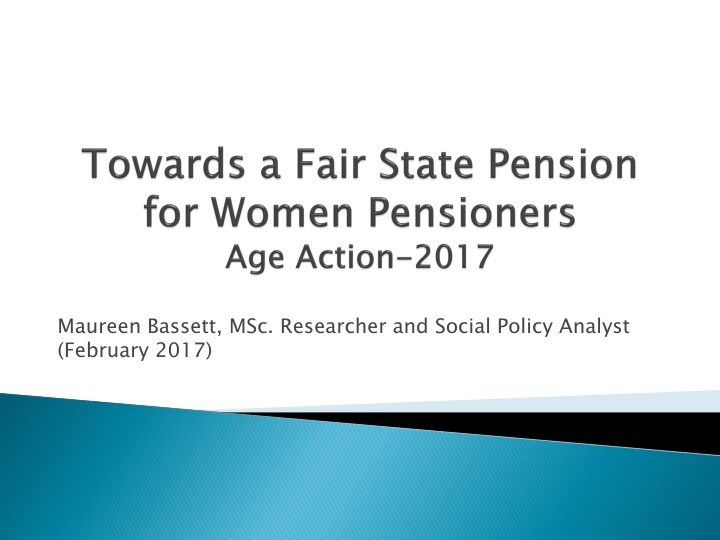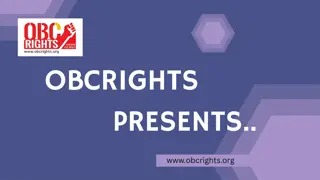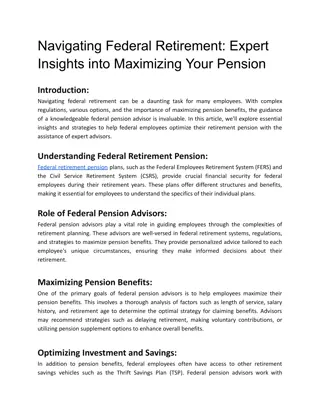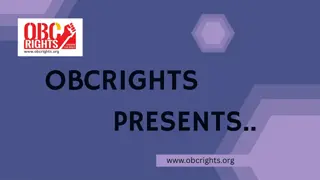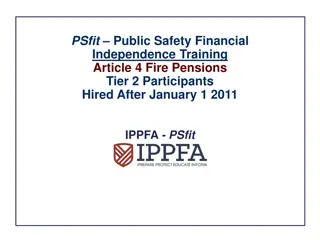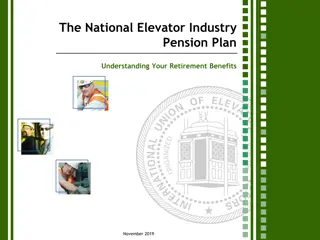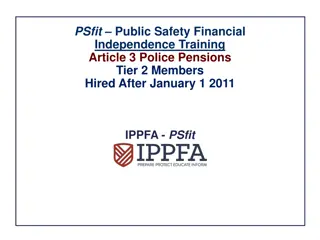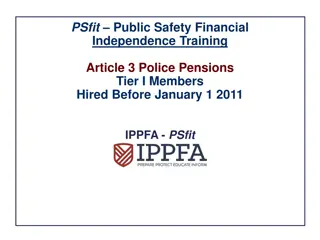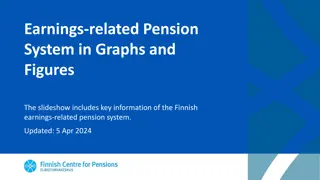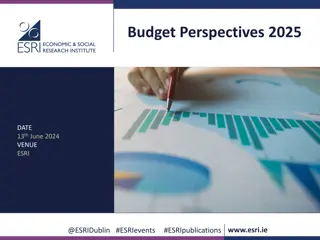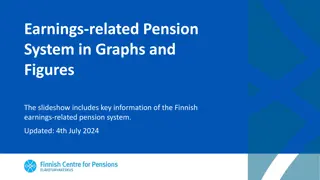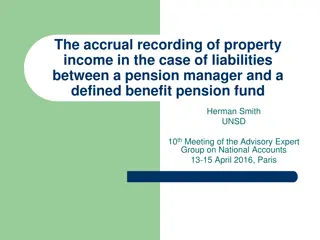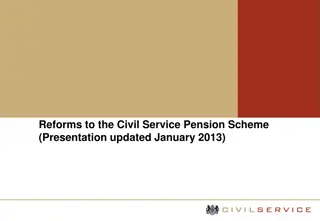Investigating 2012 Band Changes in State Pension System
This research by Maureen Bassett, MSc, aims to analyze the impact of 2012 band changes in the State Pension system on women pensioners in Ireland. The study includes literature reviews, data analysis, interviews with key stakeholders, and proposing solutions to mitigate the effects of the changes.
Download Presentation

Please find below an Image/Link to download the presentation.
The content on the website is provided AS IS for your information and personal use only. It may not be sold, licensed, or shared on other websites without obtaining consent from the author.If you encounter any issues during the download, it is possible that the publisher has removed the file from their server.
You are allowed to download the files provided on this website for personal or commercial use, subject to the condition that they are used lawfully. All files are the property of their respective owners.
The content on the website is provided AS IS for your information and personal use only. It may not be sold, licensed, or shared on other websites without obtaining consent from the author.
E N D
Presentation Transcript
Maureen Bassett, MSc. Researcher and Social Policy Analyst (February 2017)
Introduction Policy Context 2012 Band changes Case studies and Interviews Recommendations
The Aim : To investigate the extent and impact of 2012 band changes in the State Pension Contributory system on women pensioners and to propose (and cost) remedies. The Objectives: To set the context for the research by reviewing existing literature on the Irish State Pension system; To analyse and present data on the operation of the Irish State Pension; To carry out interviews with relevant key stakeholders: To ensure the voice of pensioners affected is represented by profiling case studies of individuals: To identify and cost solutions that would reverse the impact of these changes on the pensioners affected.
Literature and documentary review Semi structured interviews with: opeople directly affected (4) opeople not directly affected but with relevant issues related to the state pension-male with atypical employment and female affected by cut-off year in the Homemakers Scheme oother key stakeholders (5) including: leader of national research organisation; senior researcher and academic; leader in pension policy; DSP official working on pension policy and implementation; activist and advocate in women s and older people s equality.
Corporatist; Liberal and Social Democratic ( Esping Andersen); Ireland as Corporatist: reliance on family, religious and charitable organisations and bodies such as trade unions to provide welfare services (albeit often with state support); Move to liberal model with greater emphasis on the individual with associated risks and privatisation of services. Relevance to study: No universal pension; No or weak child care provision; Increasing emphasis on pillars two and three (private and occupational pensions) where the risk lies with the individual.
Underestimated the gendered nature of welfare states Lack of recognition of role of women in care of children and its underpinning of the state and the labour market Forefronts the idea of the male bread winner as underpinning welfare states (Lewis) Typology Strong, Modified and Weak models Ireland a strong breadwinner model characterised by dependence on women s care of children; exclusion from the labour market and as dependents in Welfare System. Relevance to study: Women s family care role shapes their participation in the work force including levels of pay and access to State Pension in own right.
Difference between women and men in level of pension income; Gap in Ireland-41 per cent (EU 27-40) for those aged 65-79 and with pensions in own right; Gap in Ireland is 52 per cent for all aged 65-79 (EU27-44); Just under one fifth of women in Ireland have no pension in their own right; Linked to gender pay gap, over14 percent in 2012,historically considerably higher Source: European Commission (2015) Men, Women and Pensions. http://ec.europa.eu/justice/gender- equality/files/documents/150618_men_women_pensions_en.pdf
Historically women less likely to participate in the labour market after having children or to have interrupted labour market participation because of their care role; Gender pay gaps in the labour market; Women over represented in precarious and part-time work; Less likely to have occupational or private pensions, if have, generally at lower investment and income levels; Much lower proportion are on the State Pension Contributory and less likely to have full rate; More reliant on lower levels of payment, that is, the State Pension Non Contributory or as Qualified Adults; Discrimination against women who cared for their families prior to 1994 in the State Pension Contributory System because of the cut-off year in Homemakers Scheme.
Austerity approachcuts to services and payments as well as additional charges and taxes; Cuts to Household Benefits Package; Introduction of prescription charges; Removal of Bereavement Grant; Removal of Christmas Bonus; Changes to conditions for eligibility to over 70 s medical card; Introduction of property tax and water charges.
Amongst Eurozone members, Ireland (with Lithuania) has lowest level of spending in 2015 at about 35 per cent of GDP; Level of spending closely linked to low level of Government revenue from taxes and social contributions-lowest in the Eurozone; (http://www.ispa.ie/images/seminars/conference_2016/conf2016 _slides/Michelle_Norris.pdf) Idea that low taxes contribute to competitiveness challenged by Social Justice Ireland amongst others; Inequality in benefits from pension related tax incentives.
Estimated figure of 2.39 billion for all elements in 2014; compared to 2.45 billion in 2005. A very small reduction during a period of deep economic crisis marked by austerity budgets. In 2014 the top 20 per cent of income earners received 73.6 per cent of this tax relief compared to 0.6 per cent for the bottom 20 per cent. Needs to be seen in context of overall spending on State Pension in 2014 - 5 billion. Source Collins, M and Hughes, G.(2016) Tax Expenditure on Occupational Pensions in Ireland http://www.nerinstitute.net/blog/2016/10/04/slides-from-neri-seminar-on- tax-expenditure-on-occ
In 2012, the State Pension System accounted for just over 63 per cent of income for people over 65. According to the National Pensions Framework (NPF-2010), the State Pension provides the only income for many people in retirement and, for many others, it represents the solid foundation on which the rest of their overall income is built . Proportion of workers (aged 20-69) who expected the State Pension to be their main source of income rose from 26 per cent to 36 per cent between 2009 and 2015. 48 per cent of those aged 55-69 expected this to be the case
Increase in contributions required to qualify for State Pension Contributory from 260 to 520 (April 2012); Increase in contributions required to qualify for Widow s, Widower s or Surviving Civil Partner s (Contributory) Pension from 156 to 260 (December 2013); Increase in contributions required to qualify to make voluntary contributions to 520 (April 2015); Change to State Pension age-age 66 from January 2014, age 67 in 2021, age 68 in 2028; Abolition of State Pension Transition from January 2014.
24 annual averaged contributions to qualify for any level of SPT payment; In 2013, only 39 per cent of those in receipt of SPT were women; Removal of SPT and change of pension age to age 66; If qualify for SPT can apply for Job Seekers Benefit (or Job Seekers Assistance); Otherwise have to wait until reach age 66 to receive payment; Full JS payment 188.00 per week v full SPC 233.30.
Type of Payment Type of Payment Total Number of Recipients Total Number of Recipients Qualified Adults Qualified Adults State Pension (Non Contributory) 95,179 3,207 State Pension (Contributory) 361,725 68,561
Lack of data from Department of Social Protection on levels; Some information in Actuarial Review (2012) of the Social Insurance Fund (SIF);Draws on 2010 data so predates band changes in 2012; Just over half of all recipients of the SPC were on the full rate; Another 21 per cent were in second band payment and receiving 98 per cent; 55 per cent of men were on the top rate compared to just under 41 per cent of women.
People affected are those in bands three, four, five and six; Significant number of people-almost 36,000 (and rising)-have lower pensions; Both men and women are affected but gendered nature of the impact is significant; Women are almost twice as likely to be affected as men; They make up 62 per cent of those who are receiving a lower pension.
Other key findings from the data include: 38 per cent of all women got a full pension compared to 66 per cent of men; More than double the number of women to men fell into band four; people in this band experience the largest reduction in monetary terms at almost 30 per week; Almost 25 per cent (10,119) of all women who were granted a State Pension Contributory fell into band four compared to just over seven per cent (4,739) of men; 11 per cent of all women fall into bands five and six compared to under five per cent of men.
To make savings-different estimates for level of these (during research DSP official indicated approximately10 million euro per year but says needs more research); To closer align level of payments with level of contributions; To ensure sustainability of State Pension System; Changes made in context of Government insistence that no cut to core payments; Changes not emphasised in main budget speeches kept under the radar .
Analysis of a comprehensive sample of PRSI contributions records carried out by the Department of Social Protection in 2011; Details released by the department to journalist Conor Ryan of the Irish Examiner -under Freedom of Information; His article highlights that a gender disparity was clear in this analysis: that documents show that the impact on the lower categories, where there was mostly women, was flagged by officials in October 2011 ( Ryan, C. 2014). http://www.irishexaminer.com/viewpoints/analysis/no-country- for-old-women-as-females-bear-brunt-of-pension-cuts-262241.html
This raises the question of whether the band changes are in contravention of Irish, EU and UN equality and human rights conventions and legislation. This needs further investigation by bodies charged with their oversight Also how do they fit with Government commitments under the National Women s Strategy (2007-2016) including objectives and commitments regarding pension income?
The Department of Social Protection as a public body has a duty to eliminate discrimination and protect the human rights of those to whom it provides services. It could be argued that the introduction of the new bands discriminates against all those affected, as they now receive a lower payment than people with similar averaged contributions who retired before September 2012 the majority of whom are women.
Forced to leave employment due to State marriage bar (1); Caring for children during 70 s and 80 s when little or no child care provided and when culturally expected; Caring for a child with intellectual disability or parents with poor health again when little or no services offered; Averaging method going back to age 16 if in employment (with PRSI contributions); even if followed by extended period out of the workforce for family care reasons: Lack of access to Homemaker s Scheme-only applies to care role from April 1994: Lack of prior notice.
The interviews with women directly affected revealed that they: Are left with a deep sense of injustice; Feel undervalued and angry : Believe are being penalised for doing what was expected of them, that is, care for their children (those with children 4 of 5 interviewed ). The significant financial losses are resulting in economic impacts including: Constantly watching what is spent: Cutting back on both essential and discretionary items: Feeling more economically dependent on husbands with a sense of reduced autonomy. Changes introduced in an underhand and sneaky way; Changes creating anxiety and uncertainly about the future amongst people not yet retired- little sense of what their pension payment will be in the future; Men with atypical labour force participation also impacted.
Irish State Pension System-sustainability and need for reform o Priorities? Reform of pillar one and/or pillars two and three; o Some concerned with over emphasis on latter pillars and move to privitisation and individualisation of risk. Economic Crisis and Rationale for Changes o Austerity approach-insufficient attention to equality and impacts on certain groups; o Changes result in reduced payments-official argument re protection of core payments not tenable; o Low levels of social investment-addiction to low taxes; o Inequality in benefits from pension related tax incentives o Tax incentives poor use of state resources-not achieving goal.
There is an urgent need to reform the second and third pillars. A key element of this is the development of a universal supplementary pension system in which the State will have to play a role (Dr David Begg). There is a need to repair the gaps and anomalies in the first pillar and to address the inequality being experienced by women before addressing issues in pillar two and three and before developing a universal supplementary pension (Senator Alice Mary Higgins).
Have to balance economic rationale with the need to ensure that people have an adequate income and a decent standard of living .which is the main purpose of State Pension policy (Professor Alan Barrett). Needs to be informed by a more holistic view of social investment which includes seeing it as productive and not passive needs to move away from an addiction with low taxes (Dr David Begg).
Tax Reliefs for Private Pensions are a poor direction of state resources; they mainly benefit high earners and the industry rather than the majority of older people .they have not achieved the policy goal of encouraging more people to invest in pensions. CSO figures show a drop in the numbers of people with private or occupational pensions (Senator Alice Mary Higgins).
Manner of Introduction o Below the radar and lack of prior notice. Unequal Gender Impacts o Continuation and embedding unequal treatment of women in the social welfare system, for example, cut off year in Homemakers Scheme; o Lack of valuing and recognition of care role; o Reluctance to address legacy issues relating to older state policies such as the marriage bar .
There is a need for a modern system of care credits (Senator Alice Mary Higgins). Investment and support for caring has to be viewed as productive (Dr David Begg). Targeted interventions now such as backdating the Homemakers Scheme could address the inequality for many of the women who are now retiring (Dr David Begg). It is critical that there is coordination between different policies and across government departments to tackle the embedded nature of women s inequality including in the State Pension system (Dr Nata Duvvury).
The issues highlighted in this report emphasise the importance of framing the pension reform agenda not only in terms of sustainability but in terms of equality. The lack of an equality focus when framing the 2012 band changes has resulted in inequality being experienced by a considerable number of older people, the majority of whom are women. This further embeds women s inequality in the system. This report calls for equality to be an overarching framework for all future State Pension policy.
The Minister for Social Protection 1. Reverse the band changes and backdate the changes so that those currently affected are placed in the bands which applied before the 2012 change. 2. Backdate the Homemakers Scheme to ensure all women retiring from now on and who cared for children will benefit. 3. Insert a modern system of care credits in the development of the Total Contributions Approach. (Conduct and draw on evidence based research to inform this development including investigation of best practice models from other countries). 4. Prioritise reform of pillar one of the State Pension system rather than the current focus on pillars two and three. In this reform ensure gender equality and income adequacy are a priority. 5. Develop data collections systems within the Department of Social Protection including gender disaggregation on the levels of payments under all State Pension schemes and include the data in Annual Statistical Reports. Minister for Social Protection should:
The Government 6. Implement the commitment in the Programme for Government to carry out and publish impact assessments based on equality principles on all future policy development. Gender proof and equality proof all future budgets and publish evidence of these in budget documents. 7. Develop a cross-departmental comprehensive long-term strategy to address the gender pension gap for current and future generations of women including targets, resourcing, implementation strategy, oversight and reporting and monitoring mechanisms. Government should:
It is recommended that the Irish Human Rights and Equality Commission: 8. Considers the findings of this report on the band changes (and the Homemakers Scheme) in light of their compliance or otherwise with national and/or international equality and human rights law and conventions. The Department of Justice and Equality 9. Ensure the new (forthcoming) National Women s Strategy includes objectives and actions to address pension inequalities for women. Irish Human Rights and Equality Commission: Department of Justice and Equality must:
